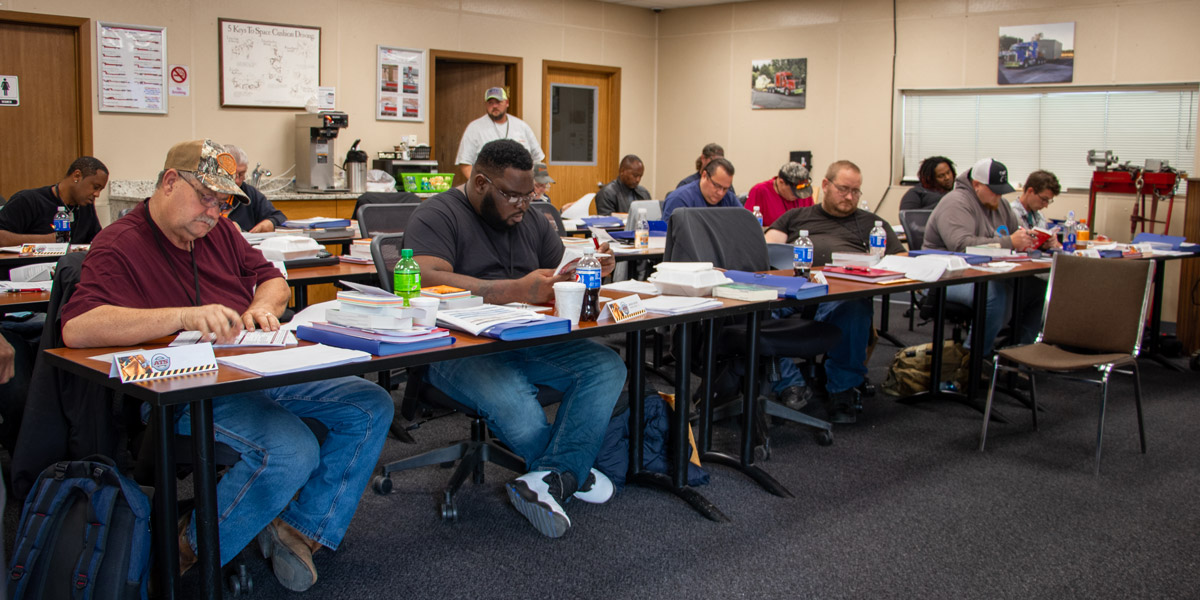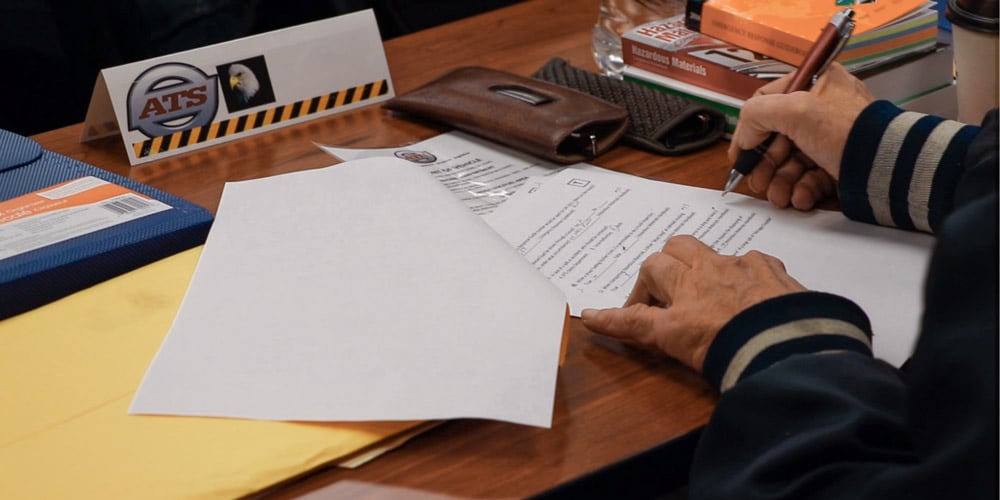Jackie is a driver manager on the specialized side and works on wind projects. She works together with customer service representatives, permit coordinators and support departments to provide the best driver experience. She loves working as a team to ensure her drivers are safe, successful and happy. Drivers aren’t a number to Jackie. They’re very important people to her and she loves getting to know them, as well as working together to work through issues and helping them maximize productivity so they can make money to go home to their families. She started with ATS in July 2018. Prior to that, she worked in sales, where she focused on building long and lasting relationships.
Give it to me straight — have you ever walked into driver orientation class and immediately known the company wasn’t right for you?
These guys have.
As a driver manager at Anderson Trucking Service (ATS), I’ve been through orientation, but I can’t speak for drivers. Not only am I not a driver, but I haven’t been to multiple driver orientations to give you a truly unbiased look at what a good orientation versus a bad orientation looks like.
That’s why I’ve recruited a couple of my flatbed lease drivers to speak to the matter.
Orientation is a driver’s first impression of the company after the recruitment process. It can set the tone for the driver’s entire experience with a company.
I don’t have to tell you what a bad driver orientation and company can mean for your life as a truck driver. Either you stay at that orientation and company and you’re miserable because they don’t have to offer what you want, or you leave in the middle of orientation and lose out on valuable time and money because you don’t have a job to fall back on.
If you can prevent either of these scenarios from happening, wouldn’t you? No one wants to end up at a company that’s a bad fit.
If you’ve gotten as far as orientation, here are some signs that you’re working with a good company versus a bad one. But before you learn the signs of a good orientation and a bad orientation, first learn more about the drivers who provided their insight.
Meet the Drivers
Greg Kelley has been driving with ATS for five years and he’s been a professional truck driver for 11 years. He bounced around a bit before he started at ATS — getting his feet wet and deciding what kind of freight he liked to haul best. He hauled general freight and did reefer for a while. He wasn’t sure he’d like flatbed, but gave it a chance at ATS and found out he loves hauling oversize loads. He’s currently slowly working his way toward the heavy haul division.
Dean Taylor has worked with ATS as a lease flatbed driver for a year. He’s been in the trucking industry for nearly six years. Like Greg, he spent some time getting his feet wet and deciding what type of freight he wanted to haul. Previously, he worked as a driver for a local beverage hauler that merchandised stores.
What Makes a Driver Orientation Good?
Here are some examples from Greg and Dean that make for a great orientation and let you know you’ve found a good company.
Transparency
Transparency is key. When you arrive at orientation, it’s very clear one way or the other if the recruiter was transparent. Everything the recruiter disclosed should be true and as expected. When you show up to orientation and everything is as the recruiter says it would be, you know you’re in a good spot.
Honesty is huge. You should be able to trust that your recruiter was transparent and it’ll set you up for a good experience with the rest of the company. Then you know exactly what to expect from your time at the company.
Drivers encounter enough surprises on the road — we don’t want it from our companies, too.
A Welcoming First Impression
First impressions are important, and orientation is one of your first impressions at the company. Coming into orientation, you should get a good feeling right off the bat.
For instance, says Greg, a member of the Anderson family greeted him when he walked into orientation on his first day. That meant a lot to him.
You should feel welcomed immediately. The last thing you want as a driver is to be treated like a number, like a cog in the wheel. You’re a person and you should be treated with respect. If you don’t feel respected and welcomed at orientation, that’s a red flag.
A Clear Schedule That’s Adhered To
Drivers are set up for success when there’s a clear, organized agenda that’s closely followed during orientation. For instance, Dean talks about enjoying the rubric he received at ATS driver orientation and how closely everyone stuck to the agenda.
It’s nice when everything is well-organized. You know what to expect, when you’ll learn about certain topics and when you’ll be able to ask questions. The training should be in-depth and cover all the material you need to succeed.
Answered Questions
Every question you have should be answered when you get to orientation and all departments should align and have the same answers. If each department is telling you something different, it’s not necessarily a red flag, but it’ll certainly require some further digging on your part.
If your questions aren’t answered during presentations, you should at the very least have time to ask your questions or sit down with someone one to one to talk over any concerns or follow-up questions. You shouldn’t leave orientation with any questions about how to do your job or who to go to for support.
What Makes a Driver Orientation Bad?
Here are some examples from Greg and Dean that make for a bad orientation.
Misleading Information
When you get to orientation and you realize the recruiting team wasn’t being entirely truthful about something, that can be a dealbreaker. You could easily end up at a company you want nothing to do with.
For example, Greg talks about attending orientation at a company where he found out on day one of orientation that he’d have to be a company driver for a year and he’d be on forced dispatch for the duration of his time with the company. Recruiting failed to mention that when he signed on to be a lease operator.
When you uncover misleading information in orientation, it makes you wonder if the company is being untruthful about other information — information that’ll come out the longer you’re with that company.
It’s important to also remember that you shouldn’t immediately assume someone on the team or the company overall is lying to you. Do some more investigating before you decide to leave orientation. There could be some sort of misunderstanding and you owe it to yourself to figure that out.
Orientation is Virtual or Very Short
While some drivers may prefer virtual orientation, sometimes they’re simply not as thorough and don’t leave you feeling well-equipped to handle the job.
The same goes for orientation that only lasts a day or two, max. It’s hard to feel well-equipped for a job when information is crammed into a short timeframe or there isn’t time to cover all the important information you need at all.
Some drivers prefer short or virtual orientation, it’s true, but if they aren’t done the right way, they can leave something to be desired. If orientation is short, there should be good follow-up after to ensure drivers feel supported. If orientation is virtual, it needs to be user-friendly, informative and well-organized.
This brings us to our next point.
Orientation is Unorganized
A well-organized orientation sets you up for success. You know what to expect every day, when you can ask your questions and when you’ll be covering the topic you want to learn about most.
An orientation where team members jump around a lot makes the company seem unorganized. It can leave you feeling like you’re missing something.
You Don’t Feel Welcome
If you don’t feel welcome, and team members make you feel like a burden, that’s a big red flag. Some companies will even require drivers to have permission to enter the building. That just doesn’t feel good as a driver. You don’t feel respected or like a valued member of the team.
What Happens if it Doesn’t Work Out at Driver Orientation?
Trust your gut if you sense something is off about the company when you attend orientation. Your feeling is probably correct. You don’t want to spend time working at a company that isn’t going to treat you right or provide you with the things they promised on the phone during the recruitment process.
You may lose time and money, but it’s okay to leave orientation and say no to the company. Remember, you aren’t a hired driver (or a driver with an independent contractor agreement) until you complete orientation and certify with the company. Take a step back and consider if this is the right move for you. Then move on and start your next search for the right company. Check out the best companies to work for this year.
Wondering what happens if it doesn’t work out at orientation? This article provides tips about preventing this experience and what to do next if you decide to leave orientation.



